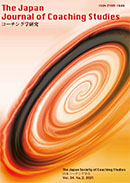Volume 34, Issue 2
Displaying 1-11 of 11 articles from this issue
- |<
- <
- 1
- >
- >|
Original articles
-
2021Volume 34Issue 2 Pages 107-114
Published: March 20, 2021
Released on J-STAGE: May 27, 2021
Download PDF (843K) -
2021Volume 34Issue 2 Pages 115-123
Published: March 20, 2021
Released on J-STAGE: May 27, 2021
Download PDF (388K) -
2021Volume 34Issue 2 Pages 125-137
Published: March 20, 2021
Released on J-STAGE: May 27, 2021
Download PDF (849K)
Research data
-
2021Volume 34Issue 2 Pages 139-150
Published: March 20, 2021
Released on J-STAGE: May 27, 2021
Download PDF (2000K)
Report
-
2021Volume 34Issue 2 Pages 151-152
Published: March 20, 2021
Released on J-STAGE: May 27, 2021
Download PDF (213K) -
2021Volume 34Issue 2 Pages 153-154
Published: March 20, 2021
Released on J-STAGE: May 27, 2021
Download PDF (180K) -
2021Volume 34Issue 2 Pages 155-156
Published: March 20, 2021
Released on J-STAGE: May 27, 2021
Download PDF (225K) -
2021Volume 34Issue 2 Pages 157-158
Published: March 20, 2021
Released on J-STAGE: May 27, 2021
Download PDF (203K) -
2021Volume 34Issue 2 Pages 159-161
Published: March 20, 2021
Released on J-STAGE: May 27, 2021
Download PDF (191K) -
2021Volume 34Issue 2 Pages 162-163
Published: March 20, 2021
Released on J-STAGE: May 27, 2021
Download PDF (271K) -
2021Volume 34Issue 2 Pages 164-165
Published: March 20, 2021
Released on J-STAGE: May 27, 2021
Download PDF (166K)
- |<
- <
- 1
- >
- >|
